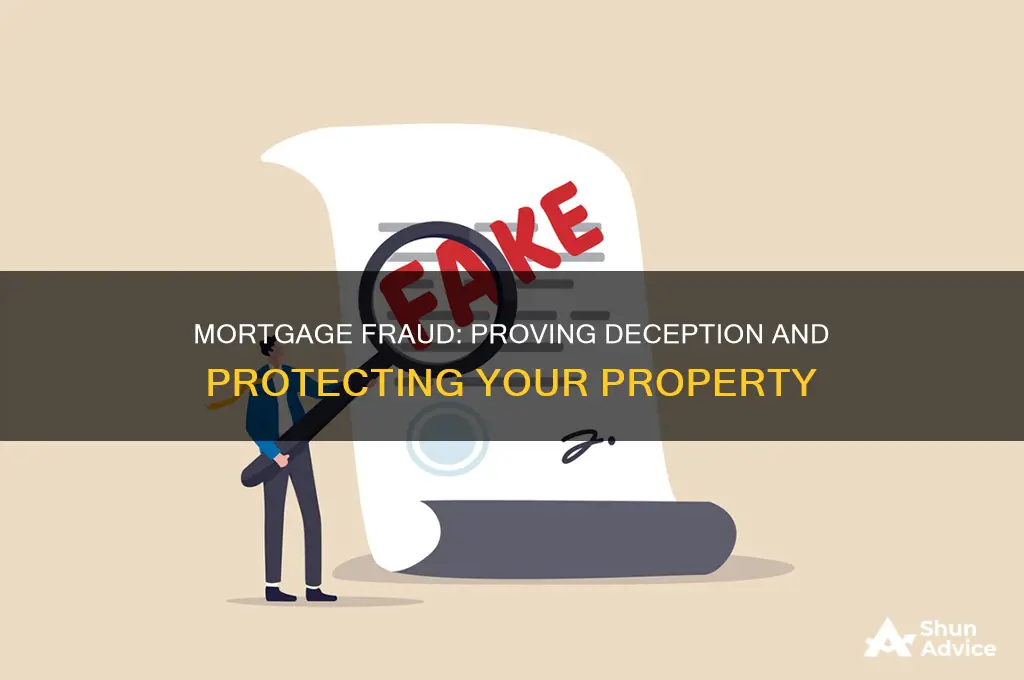
Mortgage fraud is a financial crime that involves the falsification of loan documents or other attempts to profit from the mortgage loan process. It is a significant issue that affects the financial health of lending institutions, the stability of the housing market, and the economy as a whole. Detecting and proving mortgage fraud requires vigilance and a multi-faceted approach, as fraudsters employ various schemes and tactics to deceive lenders and homeowners. Some common types of mortgage fraud include straw buying, air loans, double sales, property flipping, occupancy fraud, identity theft, income/asset falsification, and mortgage wire fraud. Recognizing red flags, such as inconsistent documentation, rapid property flipping, and credit history inconsistencies, is crucial for early detection and prevention. In the case of suspected mortgage fraud, individuals can report it anonymously or seek legal guidance to navigate whistleblower regulations effectively.
| Characteristics | Values |
|---|---|
| Common Types | Identity theft, income/asset falsification, appraisal frauds, air loans, property flipping, occupancy fraud, straw buyer scam, non-arm's length transaction, mortgage wire fraud, double sale, builder bailout, buy-and-bail |
| Red Flags | Inconsistent documentation, rapid property flipping, loan application discrepancies, upfront fees, credit history inconsistencies, spelling errors, mismatched addresses, altered documents, same phone number as employer |
| Reporting | Can be done anonymously to the FBI or other enforcement agencies. Whistleblowers may receive a percentage of the monetary sanctions collected by the government. |
What You'll Learn

Inconsistent documentation
Loan application discrepancies are a common issue. For example, an income that seems too high for the applicant's job, mismatched addresses on W-2s and bank statements, or altered documents. Other warning signs include varying signatures, mismatched names or addresses, or different handwriting on the same form.
Employment discrepancies are also a cause for concern. For instance, a borrower may present fictitious proof of employment, such as fake pay stubs and employer documentation. Lenders should investigate to ensure the listed employer is a legitimate business with a verifiable location and carefully examine pay stubs.
In other cases, there may be inconsistencies in the loan file, indicating potential misrepresentations. This could include power-of-attorney documentation that conflicts with physician letters and dates regarding the competency of a senior borrower. Additionally, lenders should be cautious if the loan officer's bank account reflects large deposits or withdrawals inconsistent with their income.
Mortgage fraud can also involve the misrepresentation of occupancy. In these cases, the borrower claims that the property will be their primary residence to obtain better loan terms, when in fact, they intend to use it as a vacation home or investment property, or not occupy it at all. Lenders should be vigilant for appraisals that include expected rent payments or very large down payments, which could indicate this type of fraud.
Understanding Non-Recourse Mortgages: What's Your Risk?
You may want to see also

Property flipping
To prove mortgage fraud in the context of property flipping, one must demonstrate that the flipper intentionally misrepresented or omitted crucial details about the property to deceive buyers and lenders. This can include providing false information about the property's condition, value, or potential, as well as hiding any known defects or issues that may affect its value.
For example, a flipper might acquire a distressed property in need of extensive repairs and renovations. They may then make cosmetic improvements that only address surface-level issues while neglecting more significant problems, such as structural damage or faulty plumbing. By disguising the true condition of the property, they can list it at a much higher price than what they paid, attracting unsuspecting buyers and lenders.
To prove mortgage fraud in such cases, it is essential to conduct a thorough investigation of the property's history, including previous sales records, renovation permits, and inspection reports. Comparing the property's condition at the time of purchase with its state at the time of sale can reveal discrepancies and uncover evidence of misrepresentation. Additionally, reviewing comparable sales data and seeking expert opinions on the property's true value can support the argument that the flipper intentionally inflated the price to defraud buyers or lenders.
Another common tactic in property flipping schemes is illegal property value inflation. This involves falsifying comparable sales data, providing false appraisals, or creating fake buyer competition to justify a higher selling price. To prove fraud in these cases, it is crucial to examine the flipper's financial records, including bank statements, loan applications, and any communications with lenders or buyers. Look for signs of inflated income, false employment information, or misleading representations of the property's value.
Becoming a Licensed Mortgage Originator in Texas
You may want to see also

Misrepresentation of employment
Mortgage fraud is a serious issue that can have significant consequences for those involved. It is important to be vigilant and aware of the different types of mortgage fraud to protect oneself and the stability of the housing market and financial system. Misrepresentation of employment is a common type of mortgage fraud that involves a borrower presenting fictitious proof of employment, such as fake pay stubs and employer documentation. This type of fraud is often committed to qualify for a mortgage or to obtain more favourable loan terms.
To detect misrepresentation of employment fraud, it is crucial to look for discrepancies between the borrower's life experience and their claimed job title and income. For example, if a borrower claims to be a high-earning executive but their age, education, or work history does not align with that position, it could be a red flag. It is also important to verify the legitimacy of the listed employer by ensuring it is a real business with a verifiable location.
Lenders and financial institutions play a crucial role in preventing and detecting misrepresentation of employment fraud. They should be thorough when examining pay stubs and other employment-related documents. Additionally, lenders should follow their financial institution's reporting protocols and government-sponsored enterprises' (GSEs) guidelines for reporting and addressing suspected mortgage fraud.
In some cases, misrepresentation of employment fraud may be part of a larger scheme, such as a straw buyer scam or occupancy fraud. It is important for lenders to be vigilant and look for other indicators of fraud, such as a lack of interaction between the lender and the buyer or rapid property flipping. By being proactive and diligent, lenders can help minimise the impact of mortgage fraud and protect the interests of all parties involved.
If you suspect misrepresentation of employment or any other type of mortgage fraud, it is essential to report it through the proper channels. Many jurisdictions allow anonymous reporting, and there may be legal protections and financial rewards for whistleblowers. However, it is recommended to seek legal advice and follow the appropriate procedures to ensure your rights are protected.
Understanding Mortgages: Navigating the Property Buying Process
You may want to see also

Occupancy fraud
To detect occupancy fraud, lenders should be vigilant and look out for several red flags. These include appraisals that include expected rent payments, buyers who provide evidence of living rent-free, and very large down payments. Additionally, borrowers who list a different mailing address than the property address may raise suspicion. Lenders should also be cautious when there is a lack of interaction with the buyer and when the property title is transferred shortly after the sale.
To prevent occupancy fraud, lenders may require primary home loan borrowers to sign an affidavit stating that they will personally occupy the home for a specified period. This is known as an owner-occupancy affidavit. Borrowers should be transparent about their move-in intentions and notify their lender if they plan to rent out the property. Providing clear timelines and proactively communicating any changes in occupancy can help borrowers avoid allegations of occupancy fraud.
In the case of suspected occupancy fraud, lenders can impose penalties, fees, or stricter terms on the borrower. They may also call for the full loan amount to be paid immediately. If the borrower cannot pay, the lender may initiate foreclosure proceedings. Cases of occupancy fraud may be referred to the FBI for further investigation and prosecution.
To summarise, occupancy fraud occurs when borrowers misrepresent their intention to occupy a property as their primary residence to obtain favourable loan terms. This type of fraud can have significant consequences, and lenders play a crucial role in detecting, preventing, and addressing it. By being vigilant and following established protocols, lenders can help minimise the impact of occupancy fraud on the financial system and protect their interests.
Strategies for Managing Multiple Mortgages and Financial Freedom
You may want to see also

Straw buyer scam
A straw buyer scam is a type of mortgage fraud scheme in which someone purchases a home under false pretenses. The goal of a straw buyer scheme is usually to improperly obtain funds from a mortgage lender using misrepresentation in loan applications. A straw buyer is any person who purchases a home and takes a loan, claiming an intention to live in that house and pay the mortgage, even though they have no such intention. Straw buyers can be real people or, in some cases, do not actually exist.
Straw buyer fraud schemes are some of the most common types of mortgage fraud because almost every scam to improperly obtain mortgage funds needs a "buyer" who is able to apply for and qualify for the loan. The buyer may work with others, including an appraiser, a realtor, and a mortgage broker. In the simplest type of straw buyer scam, someone wants to purchase a home but does not have good enough credit to qualify for the home loan. The straw buyer agrees to take the loan and buy the home in their own name, representing to the lender that they will be the one living in and paying for the house. The straw buyer may be a friend or family member of the person who will actually be living in the home, or a stranger who is acting because of generous financial incentives. Straw buyers may be paid thousands of dollars to participate in the fraudulent mortgage application.
Realtors who participate in the schemes will sometimes inflate the home purchase price or inflate commission fees to obtain funds to pay the straw buyer. Straw buyers are also used in other real estate scams, including reverse mortgage scams and builder bailouts. In a reverse mortgage scam, a straw buyer who is a senior takes ownership of a foreclosed or low-value home. After "living" in the house for 60 days, the straw buyer takes a reverse mortgage out on the home and asks for a lump-sum payment. In a builder bailout scam, a builder needs to appear more profitable in order to qualify for a renewed loan or a new line of credit.
Mortgage fraud can sometimes be a vehicle for money laundering, especially when properties are bought to legitimize illegal funds. Red flags of mortgage fraud include inconsistent documentation, such as varying signatures, mismatched names or addresses, or different handwriting on the same form, and rapid property flipping, where a property is bought and sold multiple times in a short timeframe, often at escalating prices.
Strategies for Negotiating a Favorable Second Mortgage Settlement
You may want to see also
Frequently asked questions
Common types of mortgage fraud include identity theft, income/asset falsification, appraisal frauds, air loans, straw buyer scams, property flipping, occupancy fraud, and mortgage wire fraud.
Some red flags that may indicate mortgage fraud are inconsistent documentation, such as discrepancies in loan documents, mismatched names or addresses, and altered documents. Other warning signs include upfront fees, credit history inconsistencies, and occupancy fraud.
If you suspect mortgage fraud, you can report it to the FBI or follow your financial institution's reporting protocols. You can also contact a whistleblower attorney to evaluate your situation and protect your rights.







